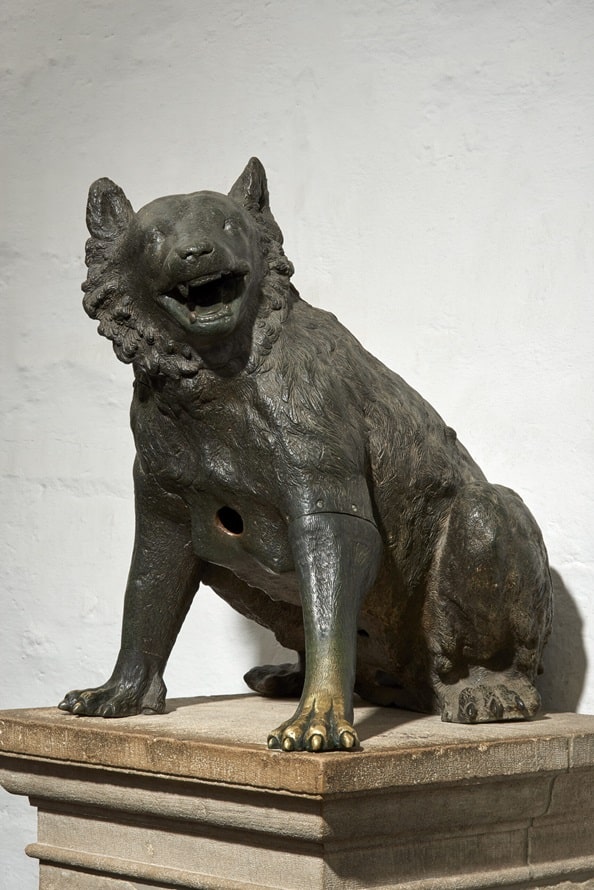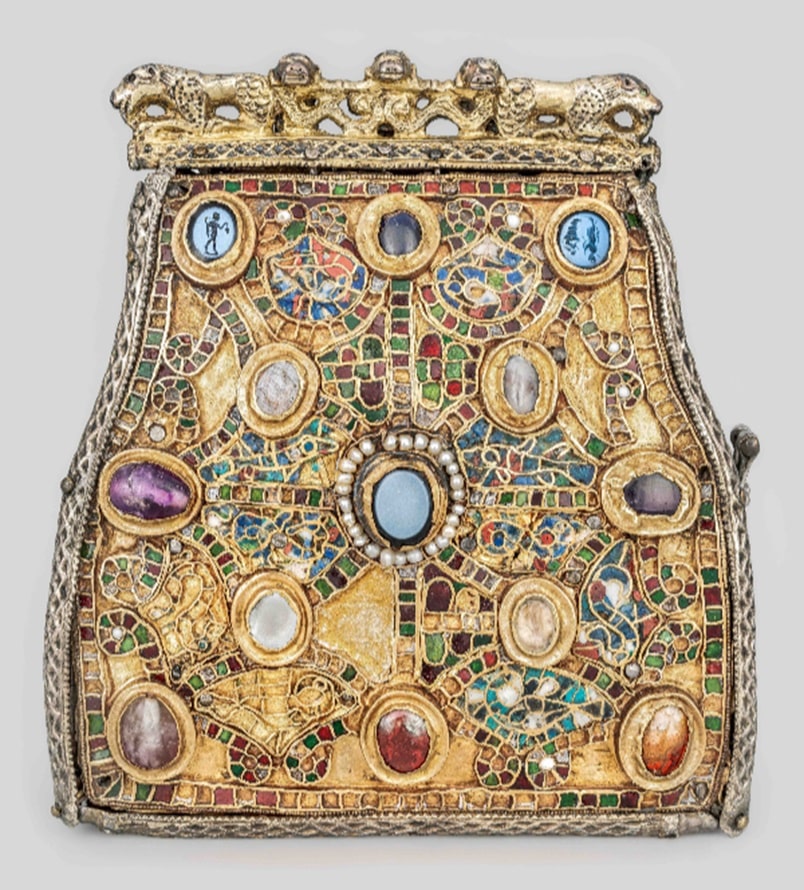It is a masterpiece of the Carolingian Frankish Empire, the Burse of Enger from the treasury of the Dionysius Monastery in Enger/Herford, which has been in the Museum of Decorative Arts of the National Museums in Berlin since 1885: Sacred medieval goldsmith’s art, decorated with gems and mythological motifs from antiquity, with precious gemstones and animal figures in the insular style. The Burse of Enger dates back to the 8th century and is one of the oldest Christian reliquaries in goldsmith’s art that has survived in Europe. Among other things, it contains some of the earliest medieval enamel work north of the Alps, which makes it particularly interesting for researchers. This outstanding work from the Kunstgewerbemuseum of the Staatliche Museen zu Berlin will be on display at the Diözesanmuseum Paderborn from September 21, 2024 to January 26, 2025.
Image above: © Staatliche Museen zu Berlin – Kunstgewerbemuseum, Photograph: Uwe Schlüter FOTOdesign
For what purpose did a medieval goldsmith create such a magnificent object? Who commissioned it? What did this bag-shaped container hold? What references does it have to antiquity?
In 2024, the Kunstgewerbemuseum of the Staatliche Museen zu Berlin and the Diözesanmuseum Paderborn initiated a large-scale restoration and research project with the support of the Ernst von Siemens Kunststiftung in order to address questions such as these using the latest technological methods. The scientific investigations will be followed by a detailed art and cultural-historical classification of the Burse and conservation measures. The occasion is the special exhibition “Corvey and the Legacy of Antiquity. Emperors, monasteries and cultural transfer in the Middle Ages”, which will open on 21.09.2024 in the Paderborn Diocesan Museum. For the first time since the “Art and Culture in the Weser Region” exhibition in Corvey in 1966, the valuable burse, which was then comprehensively conserved, will be able to travel to an exhibition again. At the Diözesanmuseum Paderborn, it is one of the highlights of the special exhibition, which shows how antiquity has shaped our ideas of politics, law, art and science to this day and how cultural techniques and knowledge were passed on to us, above all through the medieval period. The Burse of Enger will be on display here for the first time together with the closely related “Brooch of Dorestad”, a Carolingian cloak clasp with precious stones, pearls and glass from the Rijksmuseum van Oudheden in Leiden. An international specialist colloquium on the Engerer Burse and its surroundings will take place during the exhibition period and will lead to a publication, which is due to appear in 2025/2026.

Legend and meaning
“Since 1867, historians have argued that this reliquary from Enger could be directly linked to Charlemagne’s victory over the pagan Westphalians – then still called Saxons”, says Dr. Lothar Lambacher, former head curator of the Medieval Department of the Museum of Decorative Arts at the National Museums in Berlin and initiator of the research and restoration project. “The Burse von Enger dates from exactly that time.” According to various contemporary annals, Charlemagne is said to have presented his former adversary Duke Widukind with a wealth of gifts, including the Burse von Enger. It is documented that under Charlemagne, the Saxons had to swear their oath of allegiance in church or on a reliquary – a very powerful instrument, as breaking such an oath could have serious consequences.
Ancient references – Carolingian Renaissance
The burse reliquary from Enger combines great traditional lines of European art: the insular animal style with a braided band technique, as can also be found in Irish book illumination. There are references to Merovingian decorative art in the intertwining bands running around the burse. A third line of tradition is the formal language of late antique sculpture, such as in the depictions of Mary, Christ and the apostles Peter and Paul on the back of the burse, or the five cast lions on the ridge of the reliquary, which are considered the guardians of the relics kept in the burse.
Last but not least, the outstanding gems that adorn the piece offer a very direct mediation of ancient heritage. The cut stones are incorporated in second, perhaps even third use. Ancient pagan depictions of high quality were used here in a Christian context. The Carolingian Renaissance and the revival of ancient art and culture at the time of Charlemagne and his successors can be seen in the Bursen reliquary from Enger in a very unique way.
The latest restoration and conservation methods
Dr. Dorothee Kemper, art historian, DVfK Berlin, Burse research project: “Today we have the opportunity to use modern archaeometric, i.e. scientific methods, to carry out analyses on metals or even on the glass and enamel trimmings, sometimes even without contact. This was not possible until a few decades ago – you had to drill really large holes or take samples that affected the object or at least revealed flaws. It is now possible to carry out analyses, for example to investigate the gold qualities, the silver qualities or to compare them with others that are gradually becoming available for such research.” Lothar Lambacher, Dorothee Kemper, Jan Friedrich Richter and others are working together with the archaeometer Boaz Paz, the art historian Karin Wermert from the Diözesanmuseum Paderborn, who is concentrating primarily on the gems, and Wibke Bornkessel and Christian Fischer from the Berlin Museum of Decorative Arts, who are responsible for the restoration, on comprehensive scientific research and contemporary conservation treatment. Techniques used include digital 3D microscopy, X-ray fluorescence analysis, Raman spectroscopy, laser-based plasma spectroscopy analysis and infrared spectroscopy analysis.
About the special exhibition “Corvey and the Legacy of Antiquity. Imperial monasteries and cultural transfer in the Middle Ages” at the Paderborn Diocesan Museum
The abbots of Corvey Abbey had extensive connections to Rome and Byzantium and were among the scholars of the Carolingian court. They made the abbey on the Weserbogen a center for the transmission of ancient writing, architecture and wall painting. The special exhibition marks the 1,200th anniversary of the founding of the abbey and its World Heritage recognition 10 years ago. It shows how ancient knowledge and culture reached the present day via the Middle Ages and continue to shape our European society.

The exhibition brings together unique loans from museums and libraries throughout Europe and the USA. These include fascinating exhibits such as the Burse of Enger. From the vestibule of Aachen Cathedral comes the famous bronze bear, the ursa, for which the exhibition will be able to present the latest research findings. The Musée de La Cour d’Or in Metz is sending the surviving parts of the richly decorated sarcophagus of Louis the Pious, the founding father of Corvey Abbey, to Paderborn. The famous Abbey Library of St. Gall borrows precious fragments of a work by the Roman poet Virgil, and a medieval copy of the Annals of the Roman historian Tacitus is returned to its “East Westphalian homeland” from the Biblioteca Medicea Laurenziana in Florence. The historical work covers the period from the death of Emperor Augustus to the death of Nero. The Corvey Tacitus is the only surviving copy of the text in the 16th century. The Medici had the book taken from Corvey to Florence, where it was printed and distributed again in numerous copies. If this one copy in Corvey had not survived, we would not know today, for example, that the legendary Varus Battle took place in the Teutoburg Forest in 9 AD.
The more than 120 exhibits in the Paderborn Diocesan Museum are accompanied by virtual interventions. They provide exclusive insights into the work of restorers, researchers and scientists who are preserving our ancient heritage for us today. The significance and diversity of script and writing are highlighted by current works by the internationally active calligrapher and artist Brody Neuenschwander. A richly illustrated catalog will be published by Michael Imhof Verlag at the opening of the exhibition.
The exhibition is under the patronage of Federal President Frank-Walter Steinmeier.
WHEN?
Exhibition dates: Saturday, September 21, 2024 – Sunday, January 26, 2025
Opening hours: Tuesday – Sunday, 10 am – 6 pm
WHERE?
Diözesanmuseum Paderborn
Markt 17
33098 Paderborn






